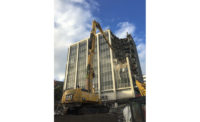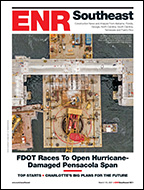
The magnitude-5.8 earthquake that rattled most of the eastern U.S. on Aug. 25 created new cracks and spalling in the upper sections of the 555-ft, 5-in.-tall Washington Monument in the nation's capital. While the extent of quake-related damage was not a surprise, the size of several spalls was larger than expected, says a forensic engineer who conducted an inspection for the U.S. National Park Service.
The survey team of Wiss, Janney, Elstner Associates Inc., Northbrook, Ill., extracted any spalls that represented a potential fall hazard and could be safely removed. The largest piece eliminated, at the southeast corner just below the monument's 55-ft-tall pyramidion, weighs 30 to 40 lb. The team also removed portions of some repairs, loosened by the quake, made during the obelisk's first full-scale renovation, completed in 2000 (ENR 7/10/00 p. 11).
Though the 127-year-old monument was not structurally compromised by the quake, subsequent discovery of displaced weatherizing mortar and cracks up to 4 ft long and 1 in. wide in the unreinforced masonry structure's outer marble-block walls have kept the monument closed to the public.
WJE first assessed the condition of the obelisk's granite-block interior walls. Then, it mobilized members of its so-called “difficult access” team—architects and engineers certified in industrial-rope access techniques by the Society of Professional Rope Access Technicians—to perform an exterior assessment using rappelling ropes and climbing gear.
The inspection team worked its way down the monument's sides over the course of a week, suspended from a secure web of ropes installed just below the monument's aluminum tip. The team was supervised by a park ranger with extensive mountaineering experience.
Cameras, masonry tools and sounding hammers helped assess each marble block for evidence of spalling. The inspectors were also armed with a digital tool: touch-screen tablets loaded with data from the renovation.
Daniel Lemieux, project manager in WJE's Washington, D.C., office, says the absence of dirt or carbon deposits in newly visible fracture-plane surfaces indicates the cracks and spalls were likely caused by the quake, centered some 84 miles away near Mineral, Va.
“We determined whether we were dealing with incipient spalls near the surface that were at some risk of separation or full-depth cracking at corners and through the body of each panel that, being inherently more stable, can be addressed as part of a more robust repair effort in the future,” Lemieux says.
“Although it appears that silicone may have been used for previous repairs, we're very sensitive to the potential for plasticizer migration to occur from certain types of silicone into marble,” Lemieux says. “We don't want any decisions we make now as part of the temporary weatherization program to handcuff us or the National Park Service later.”
Based on its findings, WJE will formulate a temporary weatherization strategy to protect the monument from water intrusion through joints, cracks and exposed natural-stone surfaces. It will also propose a long-term stabilization, repair and restoration program. WJE will work with the park service to determine if the monument can be re-opened after the temporary weatherization work is finished.




Post a comment to this article
Report Abusive Comment